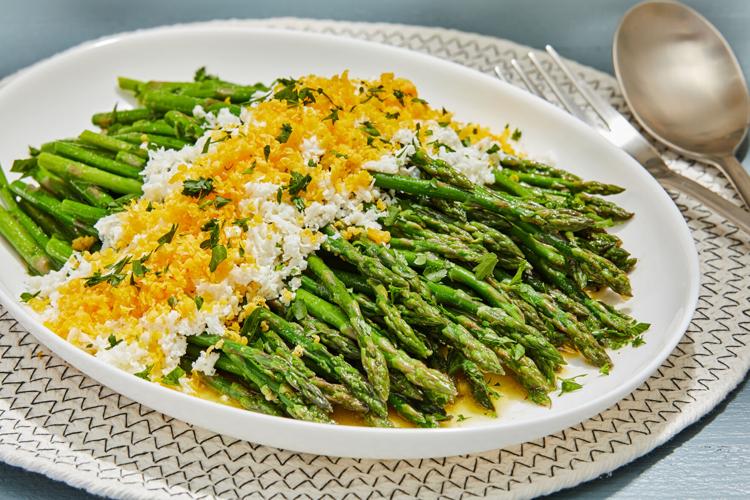
By the time spring rolls around, I am impatient for a change of pace from the cool-weather vegetables I’ve been eating for months. The first big arrival at the farmers market is almost always the slender green spears of asparagus. I greet them with the affection of an old friend, along with indecision about what to do with them.
In my mind, there’s no wrong way to cook asparagus, other than maybe boiling it beyond recognition. (If you’re not a fan of asparagus, I suspect this preparation might be why.) “Asparagus takes well to most treatments, but cooking less is more, and sometimes even not at all is best,” Abra Berens says in “Ruffage: A Practical Guide to Vegetables.

” Raw, it’s crisp, vegetal and refreshing. Cooking — briefly! — brings out depth, thanks to its inclination to browning around the edges. Because of that quick-cooking nature, you have plenty of options to choose from that require little in the way of effort, too.
Before we move on to the best ways to cook asparagus, a quick reminder of my top tips for picking and prepping it: • Look for asparagus with firm stalks, an even green color and closed, compact tips. • If you’re not using it right away, stand it up in water in your fridge, such as in a quart-size deli container or jar. • Remove grit by rinsing under cool, running water or swishing around in a bowl of water.
Then pat dry. • Trim or snap away the ends where the stalks look dry and fibrous, or take off the bottom inch and then peel the bottom half to retain as much of the stalk as possible. And now some ideas for how to make the most of this seasonal favorite.
As with most vegetables, roasting asparagus (with just olive oil, salt and pepper) is an easy, hands-off cooking method. And because it’s gentler, you have more control over the degree of doneness and more margin for error with the time before the spears veer into overcooked territory. Pick your preferred temperature, especially if the vegetables will be sharing oven space with another dish, but something on the higher end will get you crispness around the edges.
You can roast asparagus on more than a sheet pan, too. Spears also can be set on top of a piece of puff pastry and under a blanket of punchy dressing. If you’re one of those boiled asparagus skeptics, fear not.
While the asparagus goes into boiling water, it’s only for a few minutes — just long enough to take the edge off the raw spears. As with all blanching, the goal is to achieve a bright color while maintaining a pleasant snap. Plunging the asparagus into ice water prevents it from overcooking.
That’s the method you’ll find in Asparagus and White Bean Salad with Bacon Vinaigrette. As with blanching, steaming harnesses the power of water but in an even gentler form. You run less of a risk of overcooking the asparagus when it’s set over, as opposed to in, the boiling water.
Plus, the steamer makes it easier to cook the whole spears. Because the timing can vary based on the size of the vegetables and your personal preference, start checking after about three minutes. It’s still a good idea to dunk the asparagus in ice water to immediately stop the cooking and preserve that coveted color and crisp texture.
Many recipes call for steaming on the stovetop, but don’t forget about the Instant Pot. It’s powerful, so for asparagus, I’d recommend setting the timer to 0 or 1 minute on high pressure, then immediately turning off the cooker and opening the steam valve as soon as the appliance signals it’s come up to pressure. Cooking asparagus hot and fast under the broiler or on the grill allows you to impart a bit of char while still preserving a somewhat firm texture and fresh flavor.
I particularly appreciate how the feathery tips of the spears blacken and crisp, much like the edges of broccoli florets or broccolini. You’ll get even more delightful charring if you use a grill (or grill pan). If you choose to use an outdoor grill, make sure you don’t let those spears slip through the grates.
Try setting the asparagus on a grill basket, or at the very least arranging them perpendicular to the grates. Or use (soaked) wooden skewers to thread a few spears together to form a sort of “raft” that eliminates the risk of a fiery end. Similar to broiling or grilling, sautéing, stir-frying or searing asparagus allows you to apply an initial blast of heat for as little (or long) as you like.
Cook the asparagus in the pan on its own or mixed with other ingredients. Try browning whole spears or pieces cut at an angle, the suggestion in Seared Salmon With Citrus Asparagus Stir-Fry. Either way, don’t skimp on the heat.
Aim for medium-high or high heat to again achieve the balance between desirable browning and crisp-tender bite. Depending on how much color you want, you can let the asparagus sit undisturbed for a few minutes or stir constantly. Of course, the most laid-back approach is to not cook the asparagus at all.
While you could chomp straight into a raw stalk (most tempting with young, thin spears), the ideal prep for a composed dish is to break it into smaller pieces. In salads, try cutting the asparagus into bite-size pieces at an angle, which maximizes the surface area of the flesh for absorbing a flavorful dressing. Another option: Use a vegetable peeler to create elegant ribbons.
.















